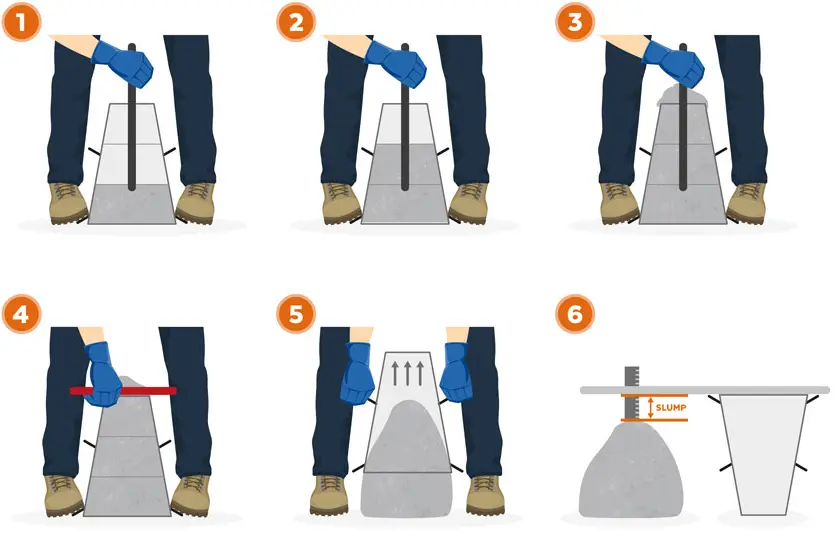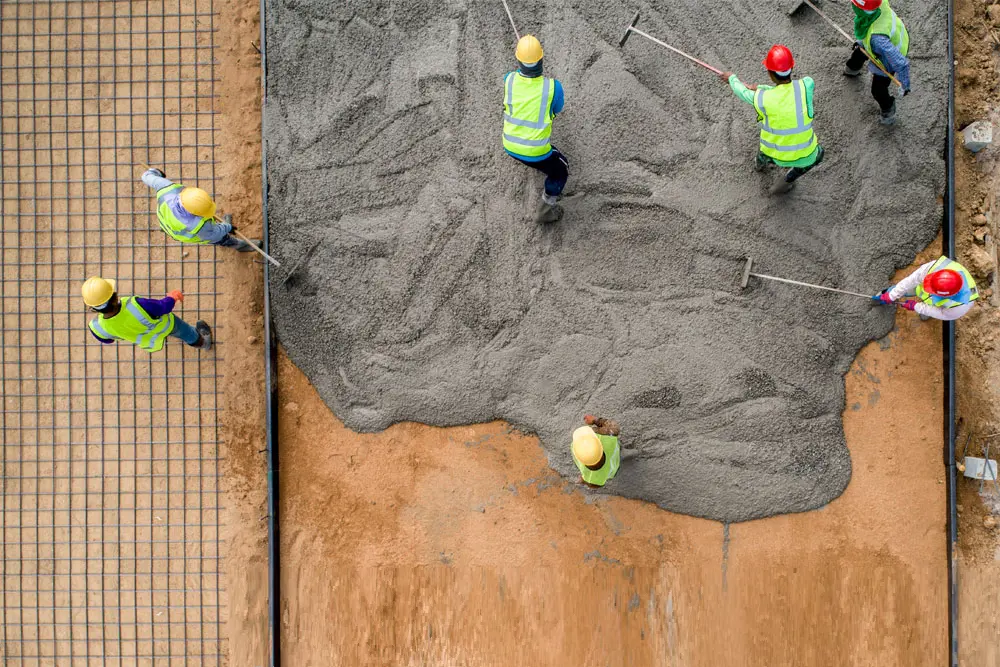The concrete slump test measures the consistency of fresh concrete before it sets. It is performed to check the workability of freshly made concrete, and therefore the ease with which concrete flows. It can also be used as an indicator of an improperly mixed batch. The test is popular due to the simplicity of apparatus used and simple procedure. The slump test is used to ensure uniformity for different loads of concrete under field conditions.
A separate test, known as the flow table, or slump-flow, test, is used for concrete that is too fluid (non-workable) to be measured using the standard slump test, because the concrete will not retain its shape when the cone is removed.
To reiterate, the concrete slump test or slump cone test is used to determine the workability or consistency of concrete mix prepared at the laboratory or the construction site during the progress of the work. The concrete slump test is carried out from batch to batch to check the uniform quality of concrete during construction. The slump test is the most simple workability test for concrete, involves low cost and provides immediate results. Due to this fact, it has been widely used for workability tests since 1922. The slump is carried out as per procedures mentioned in ASTM C143 in the United States, IS: 1199 – 1959 in India and EN 12350-2 in Europe. Generally concrete slump value is used to find the workability, which indicates water-cement ratio, but there are various factors including properties of materials, mixing methods, dosage, admixtures etc. that also affect the concrete slump value.

Which factors influence the concrete slump test:
- Material properties like chemistry, fineness, particle size distribution, moisture content and temperature of cementitious materials.
- Size, texture, combined grading, cleanliness and moisture content of the aggregates,Chemical admixtures dosage, type, combination, interaction, sequence of addition and its effectiveness,
- Air content of concrete,
- Concrete batching, mixing and transporting methods and equipment,
- Temperature of the concrete,
- Sampling of concrete, slump-testing technique and the condition of test equipment,
- The amount of free water in the concrete, and
- Time since mixing of concrete at the time of testing.
Early use of the slump test
The 6th edition of the Portland Cement Association’s Design and Control of Concrete Mixtures (1940) stated that the slump test was a rough measure of consistency – a general term meaning fluidity or wetness. It cautioned that: “This test was not an absolute measure of workability and should not be used to compare mixes of wholly different proportions or of different kinds of aggregates. Under conditions of uniform operations, however, changes in consistency as indicated by the slump are useful in indicating changes in the character of the material, the proportions or the water content.” Surprisingly, the recommended slumps for concrete were quite liberal, as follows:
- Massive sections, pavements, and floors laid on ground: 1 to 4 in.
- Heavy slabs, beams or walls: 3 to 6 in.
- Thin walls and columns, ordinary slabs or beams: 4 to 8 in.
This was in an era when concrete for building construction contained only cement, water, and fine and coarse aggregate. So an 8-in. slump was produced with water to yield concrete strengths in ranges from 2500 psi—w/c = 7-3/4 gal/sack (0.68 by weight)—to 3750 psi—w/c = 6 gal/sack (0.53 by weight). The 6th ed. also contains a suggested specification for plain and reinforced concrete, with quality based on the water-cement ratio and proper workability.
Slump limits were not specified, however. The specification required: “The proportions of aggregates to cement for any concrete shall be such as to produce a mixture which will work readily into corners and angles of the forms and around reinforcement with the method of placing employed on the work but without permitting the material to segregate or excess free water to collect on the surface.”
By 1960, ACI Committee 301 (401) had prepared a suggested Specification for Structural Concrete for Buildings, which was presented as a progress report at the March 1960 annual ACI convention. This document and future versions had significantly reduced the allowable maximum slump and slump range for vibrated concrete as shown in Table 1.
The decrease in maximum allowable slump was probably based on the assumption that higher slumps indicated higher water contents that resulted in poor quality concrete—lower strengths and water tightness. That, however, would have assumed that cement content was constant all other factors affecting slump hadn’t changed—not a bad assumption for the 1960s. Today it’s a bad assumption.
Daczco reported on results of many tests conducted on concrete mixtures made with essentially the same water and cement contents, no admixtures, but sands from two sources. Note the slumps for the following two mixtures.
The higher slump concrete has the same water content and paste content as the lower slump concrete. Other factors are at work.

